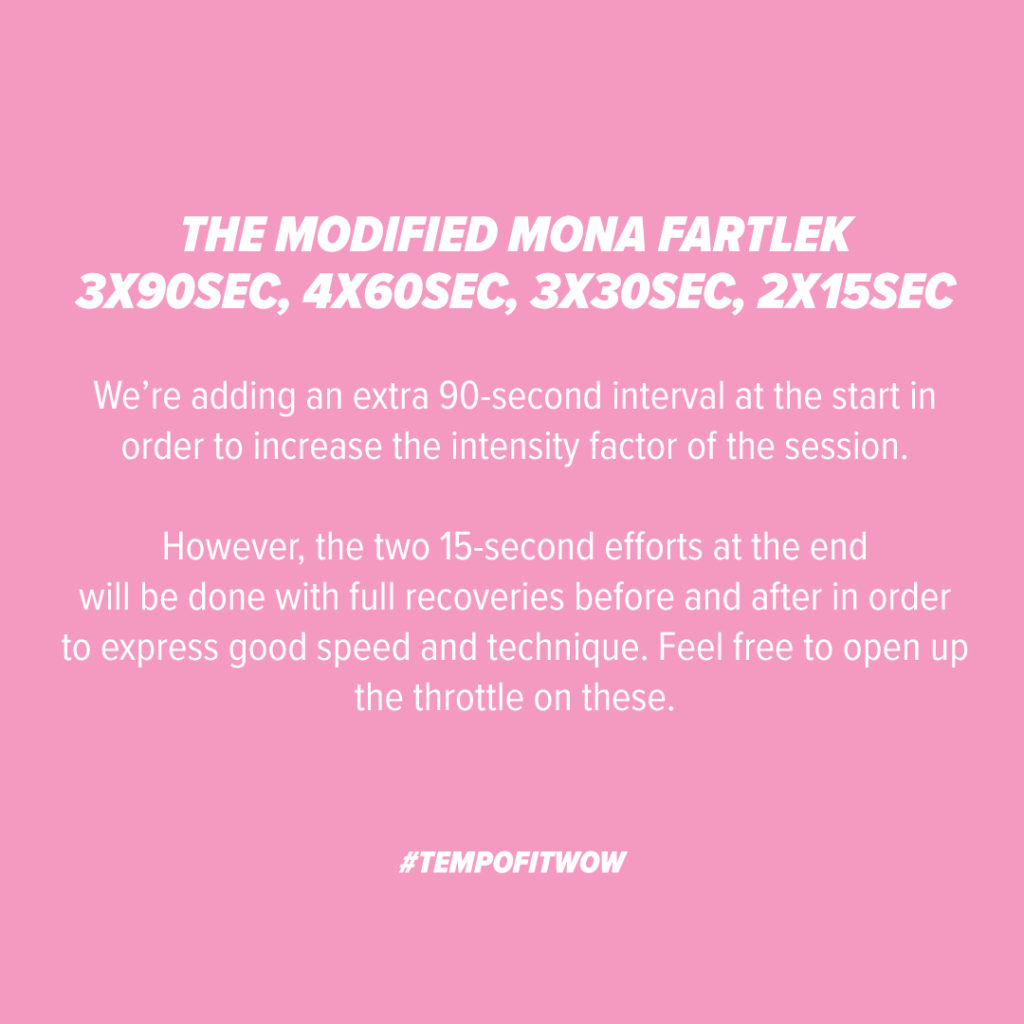
Last week we introduced a famous fartlek workout invented by Aussie distance running legend Steve Moneghetti. This week we introduce a couple of tweaks to the Mona Fartlek that make both more endurance focused and more speed orientated.
WHAT?
The Modified Mona Fartlek
3x 90 seconds
4x 60 seconds
3x 30 seconds
2x 15 seconds
Equal duration jog recoveries after each effort, except for the two 15-second efforts where you’ll take as long as you need.
Terrain: Off road surface that isn’t too technical
We’re adding an extra 90-second interval at the start in order to increase the intensity factor of the session.
However, for the two 15-second efforts at the end will be done with full recoveries before and after in order to express good speed and technique.
WHY?
The tweaks we’re making to the Mona Fartlek this week allow us to get a bit more time in at an elevated heart rate, which will be perfect prep for what’s coming next week (more on that to come soon!).
But we’re not going to let the session be all about intensity. The two 15-second efforts at the end are all about reminding your body that it can move well and fast even on pre-fatigued legs. So use this opportunity to practice great technique.
HOW?
Last week we were looking at effort levels starting around 5k race effort and finishing around mile effort. This week, feel free to up that a little. And if you’re used to running fast, perhaps the final 15-second efforts will be near max speed.
If you can, perform this week’s workout on the same trail as last week. Start from the same point and compare where you are at 20 minutes to the same spot from last week’s session.

THOUGHTS FOR THE WEEK:
DON’T LIMIT YOURSELF
By Hayden Shearman
In the past couple of weeks we’ve seen both the men’s and women’s 400m hurdles world records broken. In my opinion, 400 hurdlers are some of these most complete athletes on the planet. Especially when you compare them to your typical distance runners they illuminate a lot of areas where us distance runners can end up limiting our own potential.
So, in an effort to spot any blind spots in our training and fitness, let’s breakdown what it takes to be a 400-hurdler and how we can learn from them to become more resilient distance runners:
- Agility: It goes without saying that to do the hurdles you need to be agile to get over the hurdles as efficiently as possible. Coordination, range of motion, athleticism and great technique. Distance runners’ takeaway: How much time do we give to maintaining range of motion or doing drills to practice coordination and technique?
- Speed & Power: Sydney McClaughlin set the women’s record at 51.90 and Karsten Warholm the men’s record at 46.70. Those times are good enough to win national titles in many countries for the flat 400! So, not only is the 400-hurdler agile, they’re also FAST! Distance runners’ takeaway: The great limiter to our ability in distance running is top end speed, so even if marathons or ultras might be your goal, you still need to factor in the maintenance or development of speed to keep that ceiling nice and high. Plus, running fast is fun!
- Endurance: Despite being a sprint, the 400-hurdler needs WAY more endurance than the typical sprinter. The aerobic system will be doing everything possible to get the hurdler through the final brutal 100m. It raises an interesting question: How fast could Sydney or Karsten do a marathon? I’d argue under three hours without much specific training. Distance runners’ takeaway: We’re very much preaching to the choir with this one.
- Mental Toughness: You need to mentally strong to even consider taking on the one lap hurdle race as your event to begin with, let alone staying strong through the workouts and races themselves. Distance runners’ takeaway: When was the last time you did a session that demanded some true mental toughness? This is where doing some track racing in the summer can be so brilliant, as you can go to a pretty dark place every week to confront the beast (i.e. rather than once every six months or so in a full marathon).
- Technical Expertise: The 400 hurdles is incredibly technical. Every step in the race will be accounted for. From block starts to the speed and stride length in approaching each hurdle—everything is calculated. Distance runners’ takeaway: Thanks to the wonders of GPS watches, heart rate monitors, and Strava there is so much data that we can geek out on as distance runners. Don’t just use these as vanity metrics, but use them as signals and tools for improving your long term health and fitness.
Podcast (workout-of-the-week): Play in new window | Download
Subscribe: Apple Podcasts | RSS | More



